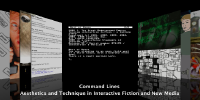
Command Lines
Aesthetics and Technique in Interactive Fiction and New Media
by Jeremy Douglass
a doctoral dissertation in partial satisfaction of the
Ph.D. in English, UC Santa Barbara (2007)
Abstract
The Interactive Fiction (IF) genre describes text-based narrative experiences in which a person interacts with a computer simulation by typing text phrases (usually commands in the imperative mood) and reading software-generated text responses (usually statements in the second person present tense). Re-examining historical and contemporary IF illuminates the larger fields of electronic literature and game studies. Intertwined aesthetic and technical developments in IF from 1977 to the present are analyzed in terms of language (person, tense, and mood), narrative theory (Iser's gaps, the fabula / sjuzet distinction), game studies / ludology (player apprehension of rules, evaluation of strategic advancement), and filmic representation (subjective POV, time-loops). Two general methodological concepts for digital humanities analyses are developed in relation to IF: implied code, which facilitates studying the interactor's mental model of an interactive work; and frustration aesthetics, which facilitates analysis of the constraints that structure interactive experiences. IF works interpreted in extended "close interactions" include Plotkin's Shade (1999), Barlow's Aisle (2000), Pontious's Rematch (2000), Foster and Ravipinto's Slouching Towards Bedlam (2003), and others. Experiences of these works are mediated by implications, frustrations, and the limiting figures of their protagonists.
Fun
Dissertation as a haiku:
> EXAMINE TEXT GAMES
...their art springs from frustration.
> PUT ART INTO THEORY
[Appearing on Dissertation Haiku ]
Citation
Douglass, J. (2007). Command Lines: Aesthetics and Technique in Interactive Fiction and New Media. Dissertation, U. California Santa Barbara.MLA:
Douglass, Jeremy. "Command Lines: Aesthetics and Technique in Interactive Fiction and New Media." Dissertation. U. California Santa Barbara, 2007.
Licensing

Command Lines by Jeremy Douglass is licensed under a Creative Commons Attribution-Noncommercial-Share Alike 3.0 United States License.
Based on a work at jeremydouglass.com.

All charts and diagrams in Command Lines are the original work of the author unless otherwise noted; these are hereby dedicated to the public domain, useable for any purpose whatsoever.
